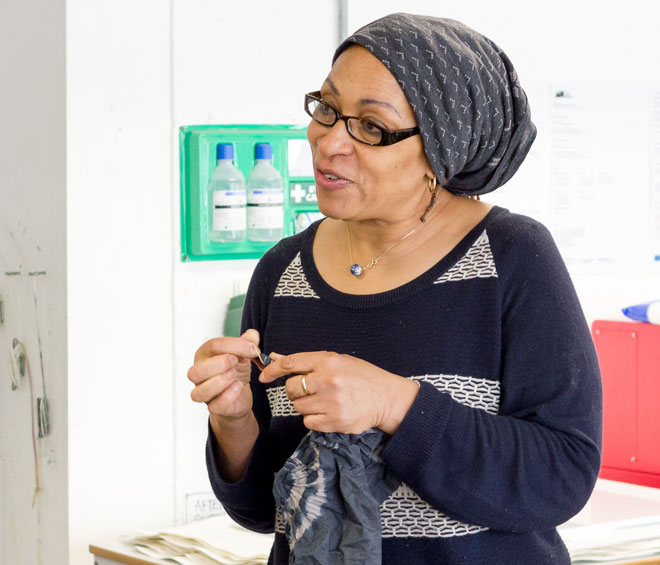
by VERONICA SIMPSON
Veronica Ryan (b1956) is a Montserrat-born British artist working primarily in sculpture, who now divides her time between the UK and New York. She is currently enjoying her first solo show in the UK for more than 15 years, at the Art House, Wakefield, following a residency this summer there and at Yorkshire Sculpture Park, as part of the Art House Change Makers programme. The resulting exhibition, Salvage, is showing until 19 January 2018. She also has a new work, Particles, on show at The Hepworth Wakefield.
This residency has allowed Ryan to continue a dialogue with Barbara Hepworth’s work that began early in her practice. As one of the rising stars of the UK scene in the 80s, Ryan helped to articulate a vital and vibrant alternative to the prevailing US / European / white art history narrative. Although she relocated to New York in the early 90s, she had the chance to explore the resonance between her sensuous sculptural sensibilities and Hepworth’s during a residency at Hepworth’s Trewyn studio in St Ives from 1998 to 2000, when she was given three pieces of marble to respond to, which Hepworth had been working on before her death; two of the resulting works are in the Tate’s permanent collection (Quoit Montserrat, 1998) and Mango Reliquary (2000).
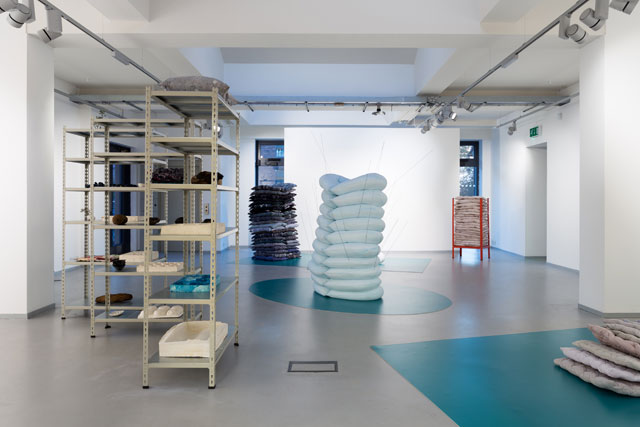
Veronica Ryan. Salvage, 2017. Courtesy of The Art House. Photo, Jules Lister. Photograph: Jules Lister.
Her work is characterised by an interest in containment and the container, probing the visual, psychological and poetic associations around what is hidden or revealed. While her early work often involved pod- or seed-like sculptures, echoing the female form and reproductive organs, Ryan’s work has become more architectural. She often uses textiles – partly inspired by her mother, a gifted quilt-maker –to interrogate ideas of emotional comfort v protection, absence v presence.
When I visit Ryan part way through the residency, she is cordial, self-contained and very much absorbed in the work. She thinks intently about questions and her answers, like her work, are often layered, tangential and crisscrossed with associations. Her studio at the Art House – after a month of exploration - displayed a number of different strands of inquiry, from fabric in various stages of being dyed or transformed into cushions to rotting yams and soursop, a tropical fruit, which she was thinking about casting (she cast a series of these in bronze, to lay on top of her Quoit Montserrat work, in the Tate Collection), along with stacked fruit trays. Elaborately tie-dyed bundles of cloth lay piled up, their corners tightly knotted and bound in elastic bands; another pile of cushions had broken free of their tie-dyed bonds and been transformed into curious quilted oblongs, gathered in dense puckerings – articulating both tension and release - their white tie-dyed motifs glowing starkly against the dark background, like an x-ray, or a visualisation of magnified cells. If they look biological, organic, “that’s partly the idea”, she says.
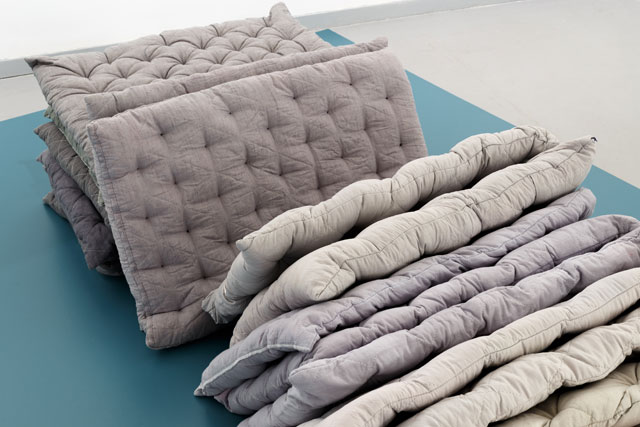
Veronica Ryan. Grey Matter, 2017. Courtesy of The Art House. Photograph: Jules Lister.
For her final show, there are several resolved sculptural pieces that take the form of stacked or piled pillows and matting, often densely puckered or patterned and sometimes pierced; one is collapsed. There is a randomness to the dying, stitching and embroidery, to intensify associations with stains, scars and tissue. Hepworth, too, was fascinated by “bones and roots and scars and tissues”, as she once noted.
The quietly unsettling presence of these works, in the context of the conversation we had around them - over two afternoons, one in July, part way into her residency, and one in November on the opening of the show at the Art House - brings to mind a quote of Barbara Hepworth’s, found in one of her midlife notebooks: “Perhaps what one wants to say is formed in childhood, and the rest of one’s life is spent trying to say it.”
,-Veronica-Ryan,-2017.jpg)
Veronica Ryan. Layered, Strata (Detail), 2017. Courtesy of The Art House. Photograph: Jules Lister.
The Art House director, Shân Edwards – who first encountered Ryan when, as a junior gallery assistant at the Camden Arts Centre, she was helping Ryan to unwrap her work for a show – hopes that this exhibition will remind the UK what a powerful talent Ryan is, and intends to tour it around other UK galleries in 2018.
Ryan was raised in north London, Watford and Montserrat, and studied at St Albans School of Art, Bath Academy of Art, the Slade School of Art and the School of Oriental and African studies (now known as Soas University of London). Ryan was awarded the Cleveland International Drawing Biennale in 1983, a Henry Moore Foundation Award in 1988, had solo exhibitions at the ICA in 1987 and Kettle’s Yard in 1988, and was included in a 1984 Tate show, Sculptors and Modellers.
Veronica Simpson: What has it been like reconnecting with your interest in Barbara Hepworth, in the place of her birth, after all this time?
Veronica Ryan: My interest didn’t really stop. Some of the work I was making at the time - moulds or cushions from fruit – I was connected with again because I got an email from [Hepworth’s granddaughter] Sophie Bowness saying they had found some of my moulds in the Palais de Dance [part of Hepworth’s St Ives studio complex, now owned by The Tate] and asking if I would like them. So I picked them up when I was over on one occasion and so the interest was still there in these particular structures. There’s a kind of continuity with those moulds and some of the work I have been making subsequently.
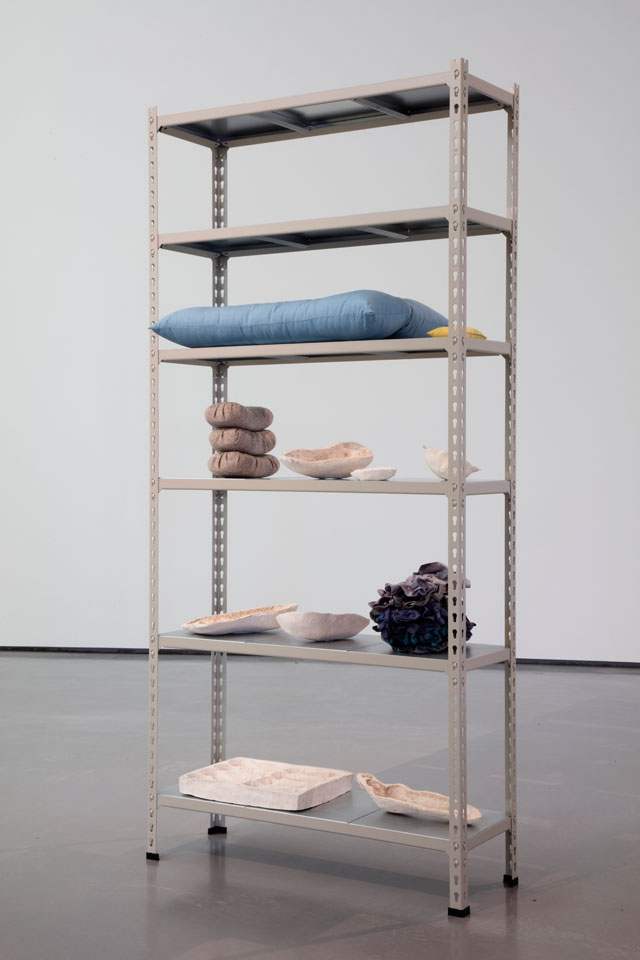
Veronica Ryan. Particle, 2017. Photograph: Jerry Hardman Jones.
While in Wakefield, I’ve been collecting fruit cushions from the shops; not just any fruit, but tropical fruit. A recurring fruit is the soursop, which looks a bit like magnolia pods. There was a magnolia tree in the garden in St Ives. Soursops, when they’re ripe, are very organic and have a connection with Barbara’s structures. There’s that connection. But I was also thinking about Montserrat and history. At one point during my residency in St Ives, it coincided with one of the volcanic eruptions in Montserrat. Somebody who had been sailing in that part of the Caribbean brought some of that volcanic ash to the studio in St Ives.
The fruit is about my own history but it is also about that connection occurring at that point, when I did the first residency. This made me think about Montserrat. I was born there, but didn’t live there. My parents went back there when I was eight. I lived there for 10 to 12 months.
VS: It must have been fascinating going to Montserrat at that age - when you are just beginning to pay proper attention to the world around you – having only really known the UK.
VR: It’s quite interesting. I try to explain to people that growing up in Watford, which was very quiet, and then going to Montserrat, at that age - around eight or nine is such a formative time for children psychologically – wasn’t really an exciting experience. Family stuff was going on that made it very chaotic. [Ryan discovered her father had another family there.] Also a plane crashed. I woke up one morning because the earth, everything was shaking. A plane had crashed into Soufrière Hills, where the volcano erupts all the time. So in my mind there are all these scary events. And finding that I had other siblings, and another sibling called Veronica. There was all kinds of very bizarre stuff that coloured my experience of Montserrat … There are a lot of psychological resonances and there are subtexts in my work, around that kind of history, what one inherits, thinking about trauma. I’m interested in the writings of two French analysts who wrote about trauma – Francoise Davoine and Jean-Max Gaudillière, authors of History Beyond Trauma – talking specifically about Jewish generational trauma and how that applies in a general sense to what one inherits.
VSimpson.jpg)
Veronica Ryan. Grey Matter, 2017. Photograph: Veronica Simpson.
So that’s a kind of context in which I work, really: thinking about history and what you remember. You know, thinking about this whole notion about psychological distress, whether it is one’s environment or one’s situation and all the research around what is genetic and what is inheritance. There isn’t any kind of definitive explanation. There can’t be … because it has to be related to individual experience.
VS: In July, you were also working on quilted elements, and we discussed the idea of quilting in relationship to the padded cell. You had been to visit one of the few remaining padded cells up at the Fieldhead Hospital Mental Health Museum in Wakefield.
VR: I’m interested in that padded cell because it’s a kind of insulated space. And now they have different ways of desensitising patients who are in acute psychiatric states: hospitals don’t put them in these cells any more; they’re drugged with antipsychotics. That, to me, is much more inhumane than these original padded cells which, in a funny kind of way, are more like a womblike space.
But the other side of things I’m interested in is the way black people are incarcerated in larger numbers - both in psychiatric facilities and in prison. What is determining the levels of anxiety that are causing this kind of vulnerability?
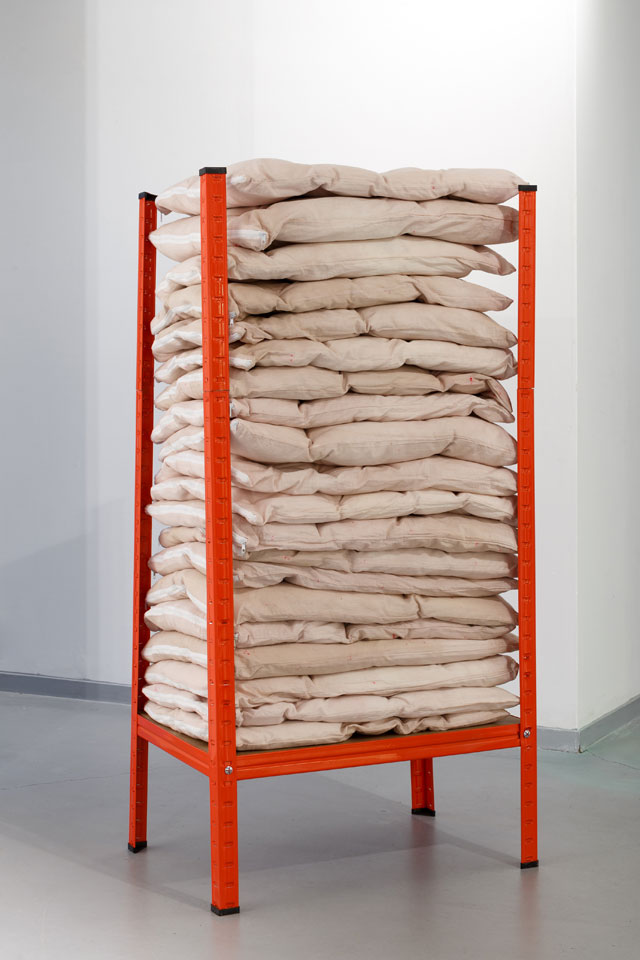
Veronica Ryan. Protectors, 2017. Courtesy of The Art House. Photograph: Jules Lister.
VS: But also the response to that vulnerability …
VR: Yes, the response. When you listen to what’s happening: that people can’t understand the levels of distress that the incarcerated are experiencing. They don’t want to be moved far away from their children or home environment. And people in authority are not understanding that in any empathic way. That is part of what’s going on in the work.
But the other reason why I’m interested in the psychiatric hospital is that it’s one of the first places that understood about post-traumatic stress; I’m intrigued by that whole area of development in psychiatry. I think because three of my siblings killed themselves, it’s not an arbitrary interest. It’s trying to understand the culture around that level of distress.
I’m interested in the semantics of perception and how, if you put 10 people in front of an accident, they are all going to experience this accident differently. I am interested in world views, in language and what we perceive, and there are these tangents that come into my thinking about the work.
VS: Stacks and layers appear to be the dominant theme in the resulting show. Can you talk me through the major piece – these pale teal, V-shaped pillows that are stacked into a tower, and pierced with long needles. This makes me think of acupuncture.
VR: Yes. They also remind me of the Sainte Sébastiennes that Louise Bourgeois did. This is titled Armour, Armature, because I put some of these needles inside to hold the structure. I was looking up the meaning of armour, and it came from Latin “armatura”, meaning arms, equipment.
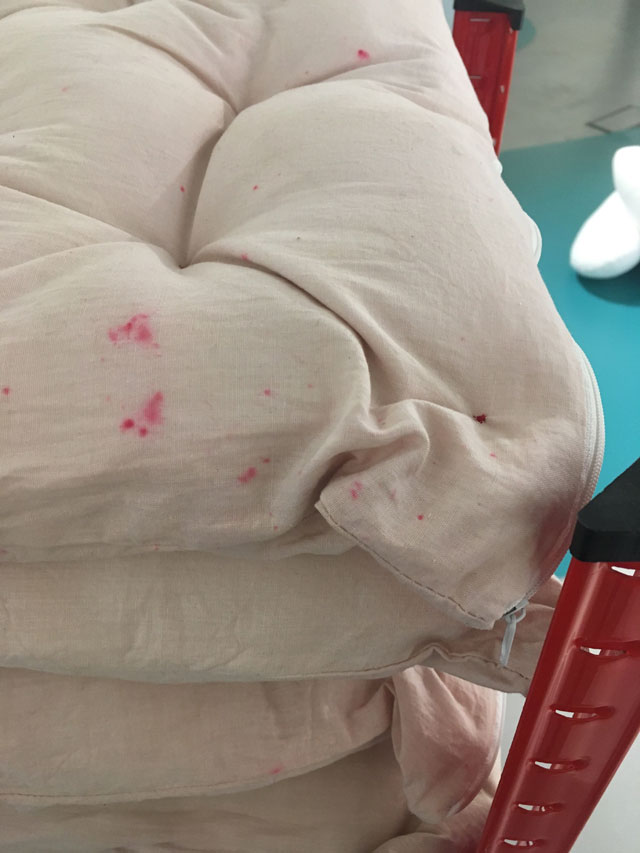
Veronica Ryan. Protectors (Detail of stains and stitches. Photograph: Veronica Simpson.
VS: So with the needles and the cushions, you are playing with the idea of attack and protection.
VR: Exactly. I liked the idea of extending the context of this conversation. And I also decided that, because it implies a kind of danger, I wanted it to have its own space. [There is a blue linoleum shape on which the sculpture sits, which serves as a defensive but open barrier.]
I have become interested in the way that pillows have this medical function for cervical, spinal problems and different kinds of pillows are used for different parts of the body. And this teal colour, because the cushions are 100% polyester, the colour doesn’t penetrate the surface. Actually I really like the (pale) result. It has this medical feel to it.
VS: Looking at the small metal bed structure here, piled high with mattresses, it makes me think of the princess and the pea, although that may be too simplistic.
VR: There is an association with that. But because they’re pillow sized it’s not [obviously a bed] … It is called Protectors. And that evolved from the sense that the covers are called (mattress) protectors. There are all these different kinds of mattresses; some are thin, some are more padded. And there’s no intrinsic way that they protect anything. I like it as a metaphorical reference. The idea that, actually, there is no real protection.
But I like the fact that there’s a bit of variation in the colours from dying. A lot of the dyes, according to how you agitate the material, have specks of pink or specks of blue. So, actually, I’ve embroidered the colours into some of the dots.
VSimpson.jpg)
Veronica Ryan. Layered, Strata, 2017. Photograph: Veronica Simpson.
VS: And here, in the corner, are two towers of the tie-dyed cushions you were starting to work with back in July.
VR: I call it Layered Strata. It’s staying within that subject matter of history and layering. The work is talking about those kinds of subjectivities, but finding its own way so it’s not a polemic, because I’ve always worked in an abstract way. I suppose also because of the Volcano in Montserrat and thinking about the land and the strata and the fact that it’s one of the most volcanic areas in the world, along with Japan.
VS: There are two pristine, white, nesting pillows here, which seem to respond to the Armour, Armature work.
VR: My earlier work was more organic in this kind of way. This piece started to come out of a conversation with Eleanor [Clayton, curator at The Hepworth]. We started to talk about what I might make in relation to Hepworth’s work. We talked about Hepworth’s nesting forms. These are pillows – nursing pillows, again – that I’ve just stuffed to get this very compressed structure. I don’t want them to look like soft, cuddly sculptures.
VSimpson.jpg)
Veronica Ryan. Armour, (Armature detail), 2017. Photograph: Veronica Simpson.
VS: And the final work, where this stack of cushions has collapsed.
VR: Yes, it’s called Grey Matter, because I was thinking of colour charts, looking at the way that grey has been used historically and in all kinds of different ways, but also about matter, as in America, with Black Lives Matter, and also “matter” in terms of our brain, but also physics. So I was interested in exploring that in its multifaceted dimension.
VS: Is there anything, at the end of this residency, that you are really excited about taking back to New York and working on there?
VR: What this has done is, specifically, it’s made a connection between the 80s work and 90s, 2000s work in New York. I think at some point it would be interesting to see some of the parts together, to see more of a direct connection because they do connect with much earlier work I made at the Slade; there’s an earlier work where I was looking at sarcophagi at the British Museum, and I made these empty box structures and filled them with plaster. Part of what I found disturbing about some of my work in the 80s was it was over-focusing on the organic part of the work. It wasn’t making connections enough with the wider context, because I was really interested in the pyramids, the interiors, the reliquary, and also west African Voodoo kind of objects. The 80s work was getting very caught up in a kind of polemic, which left out some of the investigations that I started at the Slade, and which I feel I’m connecting very much with now. And In New York when I first got there, Paula Cooper liked some of the work, the casts. But people didn’t relate to some of the more organic work. Now, people are responding much more on both sides of the Atlantic to the work, here and there. It took a while to evolve. It’s one of the things I’ve been interested in. What’s happened is that some of the younger curators I’ve been working with say that the work from the 80s is really interesting. Why don’t you make some more of these casts?
• Veronica Ryan’s exhibition Salvage is at the Art House, Wakefield, until 19 January 2018. Her new work, Particles, is currently on show at The Hepworth Wakefield.